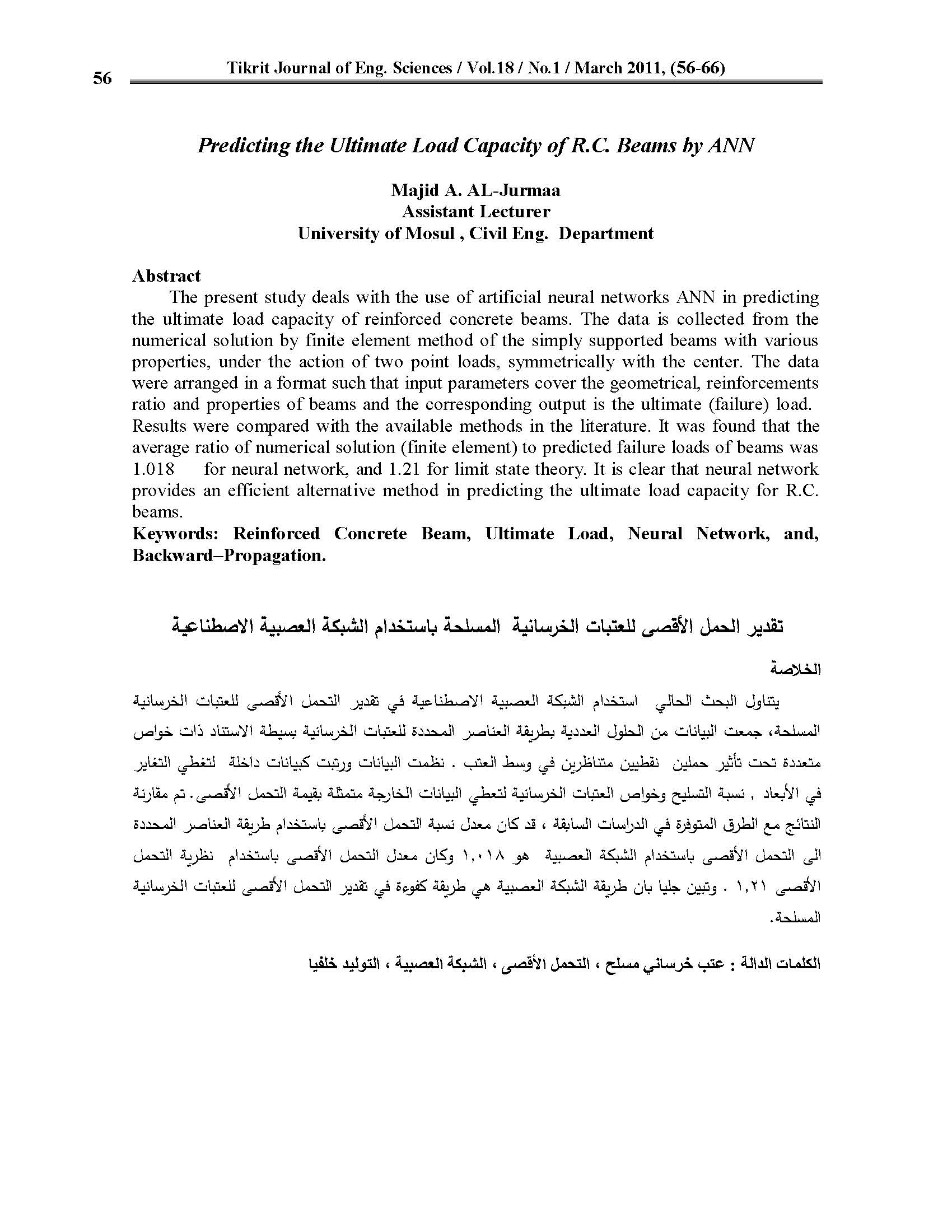Predicting the Ultimate Load Capacity of R.C. Beams by ANN
Main Article Content
Abstract
The present study deals with the use of artificial neural networks ANN in predicting the ultimate load capacity of reinforced concrete beams. The data is collected from the numerical solution by finite element method of the simply supported beams with various properties, under the action of two point loads, symmetrically with the center. The data were arranged in a format such that input parameters cover the geometrical, reinforcements ratio and properties of beams and the corresponding output is the ultimate (failure) load.
Results were compared with the available methods in the literature. It was found that the average ratio of numerical solution (finite element) to predicted failure loads of beams was 1.018 for neural network, and 1.21 for limit state theory. It is clear that neural network provides an efficient alternative method in predicting the ultimate load capacity for R.C. beams.
Metrics
Article Details

This work is licensed under a Creative Commons Attribution 4.0 International License.
THIS IS AN OPEN ACCESS ARTICLE UNDER THE CC BY LICENSE http://creativecommons.org/licenses/by/4.0/
Plaudit
References
Nilson A. H., Drawin D., and Dolan C.W.,"Design of Reinforced Concrete Structures", Mc Graw Hill, Higher education 13 th. ed, 2004, pp745.
WanShui and Nilseen P.,"Determination of Load carrying Capacity of Perfectly-Plastic structures by a Series of Linear –Elastic Solution", Danish Society for Structural Science and Engineering, Vol.73 No.2,2002, pp.39- 59.
Bonetti R.A., "Ultimate Strength of the Local Zone in Load Transfer Tests" M. Sc. Thesis, February, 2005, Virginia Polytechnic Institute and State University, Blacksburg, VA., pp, 86.
Chen, X.X., Hui Z.L., and Song "Numerical Analysis of Ultimate Strength of Concrete Filled Steel Tubular Arch Bridge”, Journal of hejiang University Sciences, 2005, 6A DOI: https://doi.org/10.1631/jzus.2005.A0859
(8) , pp.859-868. 5.Sanad, A.and Saka M. P. ," Prediction of Ultimate Shear Strength of Reinforced Concrete Deep Beams Using Neural Networks", Journal of Structural Engineering, ASCE, Vol. 127, No. 7, July, 2001, pp. 818-828. DOI: https://doi.org/10.1061/(ASCE)0733-9445(2001)127:7(818)
Tang C.W.,"Using Radial Basis Function Neural Networks to Model Tensional Strength of Reinforced Concrete Beam", Computer and Concrete,Vol.3,No.5, 2006, pp, 335- 355. DOI: https://doi.org/10.12989/cac.2006.3.5.335
Alcantara N.P. and Gasparini .E,"Steel Bars Identification in Reinforced Concrete Structures by Using ANN and Magnetic Fields", Progressinelectromagnetic Research Symposium China, August 2005, pp,22-26.
Amayreh L. and Saka M. P., "Failure Load Prediction of Castellated Beam Using Artificial Neural Networks ", ASIAN, Journal of Civil Engineer
(Building and Housing Vol., 6, NOS. 1-2 , (2005), pp, 35-54.
Rao H. S. and Babu B. R., "Hybrid Neural Network Model for the Design of Beam Subjected to Bending and Shear", Sadhana Journal, Vol. 32,
Part 5,October,2007, pp.557-86.Printed in India.
Ferguson P.M., "Reinforced Concrete Fundamentals", Third, edition, 1973, pp.750.
Cheung W.H., "Neural Network Aided Aviation Fuel Consumption Modeling", M. Sc. Thesis, Blacksburg, August 1997, pp.165.
Yousif S.T., "Artificial Neural Networks Modeling of Elasto-Plastic Plates", Ph.D. Thesis, University of Mosul, 2007.pp, 222.





